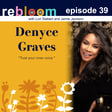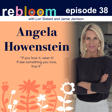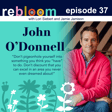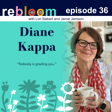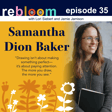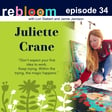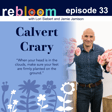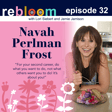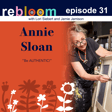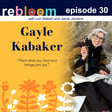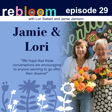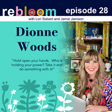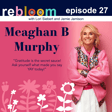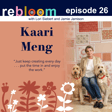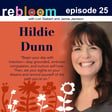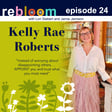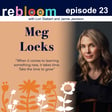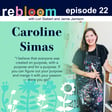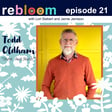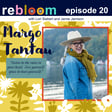Dreams and Creativity in the Workplace
00:00:01
Speaker
Do you have a dream that is a small seed of an idea and it's ready to sprout? Or are you in the workplace, weeds, and you need to bloom in a new creative way?
Embracing a Joyful Life
00:00:12
Speaker
Perhaps you're ready to embrace and grow a more vibrant, joyful, and authentic life. If you answered yes to any of these, you are ready to re-bloom.
Podcast Series Introduction
00:00:24
Speaker
Welcome to the podcast where we have enlightening chats with nature lovers, makers, and artisans as they share inspiring stories about pivoting to a heart-centered passion. Hello, I'm Lori Siebert, and I am very curious to hear from friends and artisans about the creativity that blooms when you follow your heart.
Meet the Hosts: Lori and Jamie
00:00:44
Speaker
And I'm Jamie Jamison, and I want to dig deep into the why behind each courageous leap of faith and walk through new heart-centered gardens.
00:00:54
Speaker
Each episode of Rebloom will be an in-depth conversation with guests who through self-discovery shifted to share their passions with the world.
Episode Start: Guest Juan Villanueva
00:01:04
Speaker
Get ready to find your creative joy as we plant the seeds for you to Rebloom. Hello my friends, it's Lori Siebert and we are back for another episode of Rebloom and I'm here with my friend Jamie Jameson. Hi Lori, how are you today?
00:01:21
Speaker
I'm excited for this conversation because this artist is, wow, very creative. Wow is right. So we get to talk to all kinds of amazing
Juan's Artistic Beginnings in Texas
00:01:33
Speaker
artists. artists And today we are talking to Juan Villanueva, who resides in New York, but is from Texas. And hello, Juan, how are you? Hello, Lori and Jamie and all the listeners. I'm doing great.
00:01:49
Speaker
yeah Well, thank you for joining us today. We are so excited to have you. um Juan has had a really amazing career in floristry and also art, and he is here to tell us all about it today. But Juan, we love when we talk to our guests to kind of start with some of the seeds of inspiration and reading a little bit about you.
00:02:15
Speaker
I believe your seeds were started and maybe planted in Texas and maybe by your mom. So maybe you could tell us a little bit about your start and how you landed in New York. Yeah, absolutely.
Career Transition to Floristry
00:02:29
Speaker
um So yeah, I'm a second generation florist and my mother has a flower shop in Texas that she's still running. um So we catch up ah on that about every week and kind of talk about how things are going out there and ah talk shop. um But yeah, it's she opened up her shop in Texas when I was around 15 or 16. So I was the basically the shop boy that kind of water plants and blue balloons did deliveries and that sort of thing. I was never allowed to do any arrangements. ah If I was lucky during like Valentine's week, I would make bud vases for her um that she would heavily critique
00:03:14
Speaker
But ah besides that, I was basically the delivery person. um Fast forward, I moved to Chicago after graduating high school to study at the ah School of the Art Institute of Chicago um for about a year. Then I dropped out due to finances um and ah was kind of well floating around, I didn't really have a direction.
Journey to New York and Business Expansion
00:03:43
Speaker
A good friend of mine from South Texas that I had met at the Art Institute kind of caught me one day at a thrift store, ah shopping in the bargain bin for clothes, and he kind of saw it in my face, um the distress, and he was like, you have to learn a trade or get back into some kind of um trade school or or do something with your life, but you can't be floating around in the
00:04:10
Speaker
reminded me that my mother had a flower shop and that I had experience there. And so maybe that could be a direction to take in. Eventually I took his advice and found a flower shop in Chicago. ah The owner was ah kind of to train me. And so he trained me up, um yeah, slowly um developing more skills. And so that was kind of my real start in a professional flower design.
00:04:39
Speaker
But yeah, it was ah it was a slow process. From Chicago, I met my wife ah and we moved to New York eventually and worked at a flower shop there and started my business in 2008 and eight and um kind of with a handful of clients and worked my way up through um through kind of the ranks that way. um But yeah.
00:05:03
Speaker
And then now, ah kind of pre-pandemic, I started getting ah back into ah my art practice really heavily and ah last year had a solo show. So um yeah, it's been this kind of ah roller coaster of a ride, but one that's been really exciting and I think really satisfying creatively.
00:05:25
Speaker
Well, we're going to we'll come back to the art part of it. Let's start with the roots of the floristry. So I love that your mom started you in the business, but I also love that your mom kept you away from the flowers. so like as know in the fifteen year old First of all, she was keeping your her 15-year-old son busy, which is what we all need to do. um but the other yeah But the other great thing is she's showing you, she actually showed you all sides of that business because it's not just putting beautiful flowers together, there's a lot to it. And so you started
00:05:58
Speaker
sort of an apprenticeship and and not in the not so fun part of it, but um I also love that you went off to Chicago and you started with the art, but let's start with just, and Lori is an artist, just um the mechanics or the basics
Art and Floristry: A Sculptural Approach
00:06:15
Speaker
of art. I'm sure that that is a part of your, do you find that that's a part of your floristry?
00:06:23
Speaker
ah Yes, absolutely. I mean, the way I've always gone into it is thinking of the floral works as mini sculptures in a way. And so, especially once I started my own business, but ah as you mentioned, kind of learning those um preliminary skills in a flower shop really kind of helped create some some boundaries and some um paths of working um that have kind of carried through um my entire career. I think those roots are, like as you said, are are very important in terms of creating that base. it's It's interesting to me that a friend was the person who suggested you following the florist path and not your mother. So when you did decide to go that path, what was her reaction?
00:07:23
Speaker
um My mother, um amazingly, has been my like my biggest champion um since I was a child. And so like anything that I ah put energy into, she's really um been there to cheerlead and and kind of push me in whatever direction as long as it's a positive one. And so um she's always known that I've had this kind of um ability to use my hands and creative spirit and so And so anything that involves that, she's 100% for. And so for me to like go into or pivot into the floral design world, of course, she was excited about um because she had an ally. yeah and um And she knew I would excel.
Large Installations and Texas Influence
00:08:15
Speaker
um But from the beginning, she was always pushing me to be an artist.
00:08:20
Speaker
Well, in Excel, as you have, and for those um who maybe don't know, but in the floral design world, I mean, you can do the weddings, you can do um you can do small retail, but Juan, you really do large installations and your heart has taken you to some really amazing large bodies of work. Can you tell us a little bit about those?
00:08:46
Speaker
ah Sure. um So yeah, sometimes, and in thinking back on my career, which I've been doing a lot, especially ah post pandemic, kind of taking a review of how far I've come, um I kind of jokingly tell my students and myself, um you know, that might be part of me being from Texas, you know, everything gets bigger in Texas. So so ah naturally gravitate to large works, large scale works. But I think also a lot of that has to do with um where I started in the arts, which was a lot of mural work. So working on large scale, um you know, paintings ah on walls and and in specific spaces, I think really kind of helped
00:09:38
Speaker
um inform ah the floral practice. And I think that's kind of how that ties in, um is having that background, and then navigating um both of them. But yeah, the large scale works, they really make me happy um to be able to visualize a work in ah in a particular space, um and understanding what it needs to take to create that impact.
00:10:06
Speaker
Have you been, um, I don't, you might've done this, but I'm curious, I didn't see it on your
Artistic Ambitions and Celebrity Clients
00:10:11
Speaker
feed. Have you combined your painting murals with the floral installation? Like the two together? Um, no, not a, not, I don't see it. Um, not yet. It sounds interesting. It it sounds like it'd be a fun project. I don't know. I think I might be overwhelmed with that. Like thinking about it, like my mind starts going like, what can we do? I don't know.
00:10:33
Speaker
But yeah it yeah, that sounds like a ah nice project. there's a new There's a new seed for you. So Juan, tell us about some of the bigger installations. tell us Can you tell us about some of your projects? Maybe, and I don't know, spill the beans on some of your clients, because you've worked with some celebs and some pretty big clients. And maybe share some of the ones that you are so proud of and and why. Sure. um Yeah, so some large scale works um in terms of like size, um We do a lot of work at the Javits and we're getting ready to ah to put together another installation there ah come this September, but those projects are always huge. um Anything that but you do in a space like ah the Javits Convention Center here in New York City requires a lot of material and a lot of scale um because even a 10 foot or 12 foot by 12 foot floral piece looks like it's a boutonniere
00:11:34
Speaker
when you get it into a space that grand. So really um requires you to kind of rethink scale in a different way. um In terms of clients, um I have worked with um some really A-list celebrities. um When I first moved to New York um and was working for a flower shop,
00:11:57
Speaker
I was a private florist for Will and Jada Pinkett Smith. This is when Willow um was like waist high and um and her brother Jaden was ah was not much taller. They were both kids getting homeschooled and the cutest things running around ah being tedious. Yeah. yeah ah But they're they're adorable. And so that was a really interesting thing. um And there's a number of other really A-list celebrities. I did a a garden for Naomi Campbell on the West Side Highway um what yeah right before she had her child. um But yeah, the list goes on. um But really what it is to me, um and I always get asked, oh, well, how are they? And it's like you don't really
00:12:53
Speaker
you don't really talk to the celebrities that much, um if if anything, it's a passing by. um And what it really is about is about um creating a service for those clientele and having it be seamless um so that they're able to ah live their life and you're contributing some beauty to that. and ah not interfering with ah their personal lives. And so that's, I think, an important thing to know. That's, you know, it's incredible to have some of those. And yeah, it's some it's fun to do it, but from from your heart perspective. So you love creating these big installations because that's where your heart is leading you.
00:13:36
Speaker
Tell me about the feedback, though. I mean, obviously the celebs may not say anything, but even in the Javits Center, like how how do you get the feedback once you've put it up and and what kind inspires you, not only about that piece or gives you joy about that piece, but about creating new pieces?
Community and Public Installations
00:13:56
Speaker
Absolutely. Yeah. So, ah feedback, it's definitely an important factor um when working in ah large scale and public works mostly. I mean, that's what we're talking about here is these larger pieces are definitely public works as opposed to a private space like a celebrity's home ah where it's viewed by the by the family. ah But in those public spaces, those public arenas, um and the same can be said um for any mural work is the feedback is direct and instantaneous and so it's really beautiful to to experience the um appreciation that people have ah as you're working through a project and
00:14:42
Speaker
just the joy that it brings to faces. And even in something as simple as um the fragrance of people, um you know, that the flowers bring to the environment and um and they're able to come by and be like, Oh my God, it smells so beautiful. I can't wait to see you when it's done. And and those kinds of moments as you're kind of like knee deep in foliage and yeah fingers bleeding. And you've already had 12 to 15 hours put into a piece. ah And then to have that sort of thing um is really beautiful. And even the breakdowns of those large pieces, you know, as especially ah at a place like the Javits Center where
00:15:24
Speaker
as we're breaking it down, people are taking flowers home and you see them sharing flowers and breaking down the piece themselves and seeing the vendors, children come in with arm pools of ah flowers that they're carrying over their shoulders and there's like twice the size of them, ah but are taking them home to appreciate them. It's a really beautiful thing and that's one of my favorite parts of the process.
00:15:51
Speaker
and So I wonder, like I think mural art is very about community and then what you're doing with your floral installations are very much about community. Do you have any idea where that love came for you? I mean, i I've only done one mural and I experienced what you're talking about where people come by and they comment and they get their picture taken with it. And it's it's like an interaction with your community, which is really fulfilling. So I'm just wondering like where that came from for you. um I think
00:16:33
Speaker
It really came and started getting nurtured um in in and around ah my high school days, I had a really great and supportive art school teacher, Mrs. Canales, so shout out to her, ah who really kind of pushed me in the direction of creating murals as kind of ah diving into the canon of art making for Latinos. And so I think
00:17:07
Speaker
those, as we're talking about earlier, roots really helped establish that kind of ah desire to, again, create that community and that sense of community contributing to the community. um And I also think that ah coming from a small town ah where community is everything ah has really informed kind of the practice in terms of ah seeking out that community in different environments and um the need and the appreciation of of all that that that comes with ah that sense of community. I love that. I love i love that. And I love that you're creating this big, beautiful installations for people. and And I know a little secret because I talked to a mutual friend of ours, Barbara, and she said that your studio space is actually quite tiny.
Studio Life and Creative Efficiency
00:18:02
Speaker
And she said, you'd be amazed. um And so I think that that's, you know, there's many folks out there who say, I can't do it. I live in the city. I can't do art. um But you can do art and you can do large installations. Tell us, can you tell us a little bit about your studio space because this isn't going to be a visual tour. It's going to be an audio tour. What that's like and and how you do it, how you make that happen. Sure. um So yeah, it's. um ah it's it's a thing old it's its own little uh oasis matchbox however you want to put it but it is its own jewel uh here in new york city um i like to tell a story to the students that come by for studio tours um when they see the space um because they probably already perused and i've already taught them for a few days at um and so they come in and
00:18:59
Speaker
ah And they see the work online and then to see the space that um the work was created or at the very least prepped for um are pretty amazed because it was quite literally a broom closet.
00:19:12
Speaker
ah wow In our studio building, there's a large lot of spaces. I was sharing the space for a number of years um with three other floral designers entering the peak season. um As events were coming in and getting broken down, the um the studio space would end up looking like a hurricane had just blown through on days. and it was It's just not the way I operate my operating procedure. I need kind of order. Otherwise, my brain will also just scatter about and be in full chaos. And so I was begging the building ah for about a year to find me a space that was in my budget. And um there was nothing available. And one day I was using the restroom.
00:19:56
Speaker
And they had the broom closet open and I was like, oh, what about that little broom closet? They're like, no, you can't have that space. It's for our brooms. Like what? And anyway, it's too small. And I was like, no, no, no, it's perfect. You don't you don't see the potential. And so I kept begging them. Eventually they broke and they're like, we'll clean that out and you can have that space. And so this eight foot by eight foot space became mine, there was and and a room adjoining it that wasn't much bigger. ah That already had somebody occupying it. And so eventually that person left and I took over that space. So um i my complete space, I think it's 160 square feet, um but we have 16 foot ceilings. So that helps and I have a loft ah for storage. But yeah,
00:20:42
Speaker
It's ah this in incredibly small, um you know, for Texas standards space. It's the size of my mother's walk-in closet. ah But um it It serves its purpose in that it it creates a space that requires you to stay very organized and ah very efficient in in what it is that you're able to do. And so when I lead students through that walking tour of the studio, deal I kind of explained to them that this is what's possible. um
00:21:16
Speaker
to not and they do see a number of different spaces. And, um you know, my blessings to everybody out there who were have that opportunity. But for me, this is what works for me. ah And ah I have everything like a well designed kitchen where I can turn around and grab a tool without having to look back and see where where that is because everything is there.
00:21:40
Speaker
um So just being terribly efficient, it does have its own little flaws in that everything is hidden in its hidden space. And so whenever we are full production, it becomes more of a ah ballet, yeah where where our freelancers are there and we're kind of like, I need to grab this. Can you please scooch over? Or ah we need to pull the buckets out of the back hiding place or this and that. but um But as long as we stay efficient and things go back where they're supposed to at the end of the day, um the work ah that you're able to create out of a space like that, it's pretty amazing. um I would say that everything off the, out of the Instagram is um like 90% of that goes through that tiny space. Everything else we do ah open up to auxiliary spaces and ah rent auxiliary spaces in our building, but for the most part.
00:22:34
Speaker
Let's take a quick minute and thank our amazing sponsors. Our podcast is proudly brought to you today by Jet Creative and Urban Stems. Jet Creative is a women-owned marketing firm committed to community and empowerment since 2013. Are you ready to rebloom and build a website or start a podcast? Visit jetcreative dot.com backslash podcast to kickstart your journey. They will help you bloom in ways you never imagined. And bonus, our listeners get an exclusive discount when you mention Rebloom.
00:23:10
Speaker
And a huge thanks to Urban Stems, your go-to and our go-to source for fresh, gorgeous bouquets and gifts delivered coast to coast. Use Bloom Big 20 and save 20% on your next order. And don't forget to subscribe to this podcast and follow us on Instagram and Facebook at Rebloom Podcast. Thanks to our sponsors and thanks to you for joining us today.
00:23:39
Speaker
So so i because i'm I don't know anything about this world, does most of the plant material, the flowers and everything for those large installations squeeze into your space or is most of that put together on site?
00:23:58
Speaker
Yeah, so the the majority of the installations happen on site. And so that's kind of one of the things that I talked to about students as they kind of see the space because initially when I took over the second part of the space, ah which doubled the size, I thought, oh, this is going to be great. I'm going to have a space to do meetings and that sort of thing. and um During that process, I met with like one client in the space and it always made more sense for me to go to the space itself to walk through a space and explain what it is that my ideas were in terms of where flowers would live and that sort of thing.
00:24:34
Speaker
Um, on the same note, uh, and to answer your question, um, yeah, most of the installations happen on site, especially here in New York City. So all the materials go directly there and we use the space either as an auxiliary, like storage space if if need be, or I'll rent extra space. Uh, the buildings really, um, has a lot of artists and florists, and so they understand that if things live outside of your, there's some spillover outside of your door for a day or so, then that is fine as long as pathways are clear and there's no fire hazards. but
00:25:12
Speaker
you know, we do um for the large installations usually have like a little bit of spillover for not more than 24 hours. If not, we, like I said, we will ah rent auxiliary space just for like spillover and storage on a day basis. But for the most part, everything that is outside during our workday process ends up getting piled back into the space and they'll have numerous best photos of that where it gets so overwhelming that you're just like it's a it's a literal cross space and then in the morning we kind of go through and and work through it but
00:25:47
Speaker
That that's it's always worked when you wished you lived in texas just a little bit occasionally Exactly. But you know, I think that's a great lesson for our listeners too because I do I think often I get asked that question I live in ohio and I have ah a nice studio space above my garage and i'm often asked that by my when I come to new york and teach and they say but I live in a small apartment I say it's okay you can You can create beautiful imagery. It doesn't have to be in a big space. i just I do have the luxury of a little bit more space, but it's also great to kind of think and and be efficient. and and Then you really are mindful too about what you're what you're buying and what you're doing. and and That's really cool. That's neat. Do you have a favorite favorite project that you've done that you just loved from beginning to end?
Favorite Projects and Future Excitement
00:26:41
Speaker
um you know I get asked that question a lot, ah especially from students, like, oh, what's your greatest achievement? Or what's your favorite piece? And it's hard to say ah one. ah And it's something that I've been thinking about a lot ah to answer that question. um But for me, it's always the next project is always the one that I'm kind of like most excited about um in moving forward. Because for me, they're all it it really is all about a process.
00:27:10
Speaker
And so each one are like my own little children. And so it's like taking the best child out of all of them because they've all come with their own challenges and their own um successes and ah learning moments. And so for me, that's the big takeaway. um So if I had to point to one that was just like, oh, my God, this is just the dream, um I can't say that I would have one. And I'm really doing a ah This year, a big review. um you know We're celebrating 15 years in business. um Congratulations. We started in a recession, 2008, and then have gone through a couple of other ones, it seems like, and a pandemic. I was kind of ah really taking a bigger, broader view of where I'm at in the projects that I've been able to ah work through.
00:28:07
Speaker
and I still come back to ah to that same feeling of I don't really have a favorite that that stands out because they all have been testaments ah to the process itself.
00:28:21
Speaker
I think that's a really good exercise for everyone to do at some point it's because we're weak. I too love the next project always but ah occasionally when you do you're called to look back and just kind of go through and realize what you actually accomplished because a lot of us don't take the time to do that and just celebrate the wins or celebrate the learnings and just realize oh my gosh I can't believe I've I actually did that and i'm and I'm still doing it. I think that's something that more of us need to do. Give give ourselves little pats on the back yeah at some point. Yeah, I i did that and and then I think that charges you to get excited about all of the new opportunities and realize that
00:29:12
Speaker
You don't have to start having everything solved and everything perfect because you look back and you realize, oh, my gosh, when I started, you kind of like some things I've done. I look back and I laugh at what it was when I started. I'm like, oh, my God, I would never do that again. That was but I learned from that. So and that's something I think I encourage our listeners to do a little homework.
00:29:38
Speaker
Yeah, absolutely. And then, you know, Juan too, because we often don't toot our own ha horn. I also know you've won a few awards. you've You've done some really amazing work. Now I'm going to probably get this wrong because this is it Fleur de Ville? Yes. Can you tell us a little bit about that?
00:29:58
Speaker
Yeah, so Floridaville is a great organization. they ah They put on shows around the world, ah creating floral mannequins, um usually in a mall area. And so ah we participated in three um And we've won a Best in Show, Fan Favorite. um And then as a business, I um supported an intern that we worked on, Svetlana, who has her own business now as an extremely talented floral artist. But I hosted her as a floral as an residence ah in our tiny studio.
00:30:42
Speaker
And so she ah participated and won both Fan Favorite and ah Best in Show um ah the last time that we participated um where I was basically her intern and i love now help but helped her out whatever with whatever she needed to in her process. um So she kept asking me, what do what should I ask? I was like, I'm here just to support you, whatever you need from me to help you.
00:31:09
Speaker
ah execute your vision, then that's what we're here for. And you are the artist. And so, so yeah, ah we've won a number of awards at Florida Bill, and always have come with a lot of knowledge and about the floral medium ah out of those projects as hard as they are. Well congratulations and that says a lot about you as a teacher too when you see your students shine brightly above you too because I taught for many many years and it was always a greatest joy when my students were shining brighter than I was because i then then you know that you're doing your job and and that's fabulous.
00:31:52
Speaker
You were also on a competition show, am I right?
TV Competitions and Awards
00:31:56
Speaker
ah Yes. ah So during the pandemic, i well they reached out to me to be on a national network show um that ended up being HGTV.
00:32:10
Speaker
um So we filmed a ah television competition for topiary artists um just here outside of New York City ah with the host, well, I'm sorry, the judge was Martha Stewart. And so, so yeah, ah that was an exciting opportunity, really interesting ah to kind of ah go into that world of kind of reality TV. ah I learned a lot mostly about myself um in that process. I mean it was a ah really ah difficult time. We filmed at the end of October and
00:32:54
Speaker
ah Luckily, we went through the whole season ah ch shoot without having any um anybody ah coming down with COVID or having to shut down production, which was, um from what I hear, um one of the only productions that that went out that year that that had that happen, which was really great. um But yeah, it was super interesting to experience the and to participate in the in a competition of that magnitude on a national scale.
00:33:26
Speaker
What did you learn about yourself? I'm curious. You know, it's, it really became when I was there, i maybe it was the artist in me, maybe it was the teacher in me. I was there really when I saw the competition, I wanted to help everybody. they ah I think I might've been the oldest person there too, ah participant. And so,
00:33:51
Speaker
I really went into it kind of more of this community mindset and and kind of a collaborative ah mindset, which is not conducive to a ah competition reality show where we're they're looking to create the best TV. And so I found myself biting my tongue a lot of times. And and at one point I was just like, you know what, I really I think um I could help the skill set of some of the contestants. So let me try and do that the best I can. And so I really um came away with a broader sense of ah what my personal values were and what I was willing to compromise for those or not compromise, I should say. ah
00:34:37
Speaker
it even ah in a situation like that. And so ah I'm really glad that i I took advantage of that opportunity. um Like I said, I learned a lot, ah even though my parents and my wife were were pretty upset about me leaving early.
00:34:55
Speaker
but but and thought that I should have like really stuck it to some of the other contestants ah in a more competitive ah reality show type of way. But the only thing that I kept thinking was in the back of my mind was how what was my students thinking?
00:35:10
Speaker
if in the end they're like, ah saw me acting in an inappropriate or or kind of malicious way. And so it really kind of brought those values. that says That says so much about you and the son that your mother raised too. So that says a ton about you. And I'm And I'm glad, you know, yay for you, for because it's not always about winning. It's it's sometimes about love experiencing things. And so another thing, there was a lot that happened in 2020.
Pandemic Impact and Artistic Reconnection
00:35:41
Speaker
So for our listeners too, because Wands business is not a retail business. it's It's a large installation business. So things were fairly shut down for you.
00:35:52
Speaker
or really shut down for you. and But that caused you to pivot and come back to your art. Can you talk to us a little bit about that that journey and and what happened there? Yeah, absolutely. um So like like most people, i I wasn't alone in this. We all kind of experienced that time. But everybody experienced it in a little bit different way. ah My business being primarily ah event based um took a big hit. ah And so I found myself um kind of in a situation where i I really thought that I was going to have to clear out my studio and get rid of everything and
00:36:40
Speaker
and basically run, um because I also do gardens, basically run my garden practice out of a storage unit. And that's what I was prepared for. um But luckily my building, everybody in my building got together and we kind of worked with the the owners of the building and they worked with us. And so I was able to keep my tiny studio, ah you know, ah with help from the building. And ah luckily the ah keeping the space as small as it is really helped and was kind of like the saving grace. um So I was able to to keep and stay in my space and ah really begin diving back into ah the art, um which became a healing practice really, ah in terms of kind of figuring out
00:37:31
Speaker
what it is that, um, what the label is that I was creating for myself because you know, we, I was to that point always a florist because I had kind of abandoned the label as I was developing my business, um, over the, you know, 12 or 13 years that it was building it. I kind of put the brushes aside. I was being fulfilled creatively. Um,
00:37:58
Speaker
creating these events that were super innovative in my opinion. um So I didn't have a need really to express myself on canvas or in sculpture because I was doing that daily. um So when ah the pandemic hit, I almost, I felt like I lost that label of, of florist because I really, I truly believe, you know, you are what you do. And so, um,
00:38:28
Speaker
if I wasn't a florist, who was I? And so working through those issues of like, what what is this label? then Am I an artist? I'm not really making any art. And so I started delving back into that kind of um figuring out, you know, what is even my vocabulary as an artist? Am I a painter? Am I a sculptor? ah What's the materials? I hadn't, you know, really had any ah portfolio development in 12 years or so. So I had to see what was even the the vocabulary I was using as a painter. What what did that look like now? um Because we changed so much. and um And I think it was, ah like I said, a really ah was a real healing journey in terms of
00:39:17
Speaker
um interpersonal development and figuring out like who I am, what it is that I believe, what is my visual vocabulary, um and who am I um devoid of labels.
00:39:33
Speaker
um you know And so I think that ah that time in the studio and being that it was the pandemic and the building was quiet, everybody was quiet, really gave me that time to kind of delve deep into some of those issues and kind of work through and really figure out, you know,
00:39:53
Speaker
who and ah who I am and what it is that I create. um and so So yeah, I feel like a lot of those pieces are deeply personal. um Some of them were successes, some of them were not. But it was a matter of like pushing through no matter what and just creating and creating a practice of creating again.
00:40:19
Speaker
yeah in whatever material that ended up being, whether that was flowers or or painting or sculpture or mixed media or ah bio art. ah so So yeah, at um it was a a really great time and I'm still kind of in that mode. I think it really helped define who who I am now.
00:40:43
Speaker
Thank you for sharing all that. And you know I know that the the pandemic was it was so hard on everybody and and you know obviously tragic. and But yet there were many gifts and it did allow many of us to turn inward into our heart and our soul and how beautiful that you were able to do that.
00:41:04
Speaker
And to find, because I think sometimes we do get going so fast. And that's the one thing I found about the pandemic is we were forced to stop. We were forced to slow down. We were forced to take a look inward. And I think that as an artist, we all need to do. fortunately Fortunately, pray to God, we never have another pandemic. But that pause is good for all of us just to say, am I on the right path? Am I doing all the things that I want to be doing? Could I take this in a different direction? Is my heart filling up? Lori, what do you think about that?
00:41:42
Speaker
Well, I was just, ah I was just wondering what bio art is.
Exploring Bio Art
00:41:48
Speaker
I was wondering that question. All right, back what's bio art? you You were being very philosophical there. and she catch me with bio art yeah So we can give philosophical again in a minute, but yeah but we i are what bio art is?
00:42:08
Speaker
Yeah, absolutely. So I questioned that myself. um So I took a ah bio art residency a couple of years ago at SBA. And I was in this process of kind of like, redeveloping a portfolio and figuring out, you know, what it is that I do. And they had this ah ah ah artist residency in the bio art practices and I was like that sounds really cool what is that and so I went in there and that was the question to the students ah the other I'm sorry the other artists in residence and ah the staff there at SVA because I had no idea. So basically what bio art is is um utilizing um
00:42:55
Speaker
ah biological materials in a ah scientific practice um and or using any. So there's a number of different ways to look at it. It's this huge umbrella. um But it it's anything that basically has to do with ah biological materials. So it could be people that work with ah animals. There's artists that work with ah DNA. There's artists ah like myself who are florist and floral sculptors. There's artists who paint botanical works ah and paint flowers and, um you know, botanical illustrations, bottom on. So all of those kind of fall under that broader umbrella of bio art. And so I like using that now as kind of this
00:43:48
Speaker
um from a lack of a label of what it is that I do um because it is so kind of undefined and broad in its sense of all the things that you can do. But primarily it's work that would take place in a laboratory setting or some kind of investigation into the world of biology and floral, fauna, that sort of thing. So yeah, and I think it's a really interesting label.
00:44:18
Speaker
i'm I'm now moving from floral photographer to bio artist. Just in case anybody out there is listening, refer to me now as a bio artist. Absolutely. I did see a piece on your feed that you labeled as bio art. So when you brought that term up again, I needed to, it the piece is beautiful. It's exquisite.
00:44:40
Speaker
And it it like it feels like it's floral design. So everything you're doing sort of all matches together really beautifully. It tends to happen with all of our guests. It does. Juan, you have bloomed and re-bloomed, and quite frankly, thanks to the pandemic,
00:45:04
Speaker
are re-blooming again even more so introspectively and growth and your work is just phenomenal. It's it's something that brings joy to our world in such a big way.
00:45:19
Speaker
yeah thank Thank you. So we love to... Can I ask one more question? yeah Yeah, of course. Before we move to the... I'm just wondering what things look like now for you are you are you. Are you combining the floral design with your art practice? Or are you focused on one or the other? Or is there... A little bit of both. Yeah.
00:45:47
Speaker
Yeah, that's a great question. And it's something that I'm kind of still in the throes of figuring out myself, which I think it could be a lifetime pursuit, right? It's not something that needs to be decided, um you know, full stop um and something that I've been talking to my students about because ah in a way I feel like I put to rest this label of of viewing myself as an event florist or a private client florist. And so then the topic to or the the thing that needs to be discussed is as a an instructor, like why should they listen? And um I think that where I'm at now is kind of in the space where I'm
00:46:36
Speaker
breaking down all these rules and mode of working that I've had previously and kind of deconstructing it completely and seeing what what ends up coming out of that. And so taking apart all these kind of um modes of working in terms of flow design as a centerpiece or floral design as a large scale installation and how can we pull those elements apart and then put them back together in kind of this new form and really going deep and investigating like how far can we push it in both directions? How far can I bring floral materials into my painting practice? How much floral materials can I bring into a sculpture practice? How much of my floral design and ah
00:47:32
Speaker
you know, commercial installation, say for the Javits, how much can I push that so that it really becomes a bio-art practice and a bio-art sculpture ah in fine art terms as opposed to a commercial paradigm. ah And seeing you know where where those lines those lines are and how how we how I can push them and my ah and the people I work with, how far we can push them ah in this medium of kind of floral design and it works. And so that's where I'm at now.
00:48:10
Speaker
ah That's where I find myself. i and yeah Like I said, I think it's something that could be a lifetime pursuit. That sounds so exciting. so exciting I'm going to be watching and getting inspired by what I'm seeing from you moving forward because I love the combination of all of this and I love the pushing of the boundaries and the labels and what comes out of that. That's going to be really magical to watch.
00:48:39
Speaker
Very, very magical. Well, thank you, Juan. All right. So I jumped ahead and I'm, Lori, I'm so thankful you asked that last question. That was fabulous. Juan, we like to leave our listeners with a little advice. So when you are talking with your students or your staff or anyone, what's your favorite piece of advice that you like to give to folks?
00:49:00
Speaker
Uh, just to so go go ahead
Encouraging Fearless Creativity
00:49:03
Speaker
and do it. um So a lot of times um the people that have worked with me, um kind of my core crew, um they sometimes refer to me as Juan sin miedo. So in English, that's Juan, no fear. and i think And I think that comes from me always telling them that is like, just do it. Don't be afraid. If there's something wrong, I'll tell you. um
00:49:32
Speaker
you know, ah that it's wrong, or we'll work on making it better. But um I think that is the advice is like, just do just go go ahead and and start working on it. And, it you know, work through whatever problems come up as we go. And don't be afraid. And so even when I bring in a lot of my crew started off as quote unquote helpers,
00:49:56
Speaker
um that I would um get them and that's the way I run my business is that everybody um gets paid the same everybody participates the same everybody does the same amount of work and the same type of work and so a helper that comes to my crew is not a helper they're also a flower designer and I tell tell this to the students is that I do this because um ah One, it elevates our helpers and makes them designers and gives them authority over the the work that we're creating. And then also it brings down the ego of our established designers um to let them know that every job is important. And so um when those helpers begin with us, they are always up afraid. You can always see it in them. But you know there's a thing that happens where um
00:50:48
Speaker
there's a self-regulation in the culture that I've developed where communication is important. And so to have them be able to just to do the job and not be afraid that they're going to get in trouble ah by making a mistake or or having something be bad, we can always rework it.
00:51:06
Speaker
um And so um that's the biggest advice is like just to keep going, keep learning and keep ah pushing forward ah from where we're at. you know You might not know exactly what it is that you're doing, but somebody's there that can help you. And ah and that way all of us grow. All of us continue to push ourselves and get better and and contribute. And so I think that's the the most beautiful part of it ah working with other people that that is beautifully said and as you were saying all of that one i was thinking that those early days of you being a helper in your mother's studio at age 15 have all come full circle and you're treating those people with love and respect and helping them to grow just as your mother has helped you and and it's such it's been such a joy to hear about your journey and hear how you've
00:52:00
Speaker
bloomed and you're continuing to read Bloom. And I thank you. Thank you for being with us. Thank you so much, Juan. What a beautiful conversation. And I just love looking i'm and in love looking at your work. Thank you so much. Thank you for joining us today. Thank you.
00:52:17
Speaker
Lori, another fabulous conversation. I just am in awe of the journey that our guests take. What did you think about today? what The word that kept coming to me was community. I feel like Juan lives and breathes that, not only in the kind of work that he takes on,
00:52:44
Speaker
being large murals, large installations that invite and involve the ah community to interact with, but also in the way that he runs his business, yeah which I think would be such a beautiful model for other businesses to take. Because I do feel like when people are living in fear in a job that they're going to make a mistake.
00:53:12
Speaker
then that's a that's an environment where breakthroughs cannot happen. Because if everyone's afraid to even make one little move, how are they going to come up with some new invention or some new floral design or anything? so yeah and And even the way that he talked about the his adventure in reality TV, I just did a post about how the the reality TV shows, the competitions in the UK are so much kinder than the ones in the US. And I imagine the producers maybe encourage that to make a little more drama happen, which I can't, I have a hard time watching that. I like when they all like cheer each other on and support each other. And I think that is what Juan personifies. I would agree and I think what I heard so come through so loud and clear is that his creative heart, but also his teacher heart, is for first and foremost in who he is as ah as a man and also as an artist. and
00:54:24
Speaker
I think when you let your your heart and your creativity lead, then your ego comes second. And you can see that just in what he's, how he's creating is it because you can't operate in a small little eight by eight room with a team without, with having a big ego. I mean, you would, you'd be there all by yourself. And if he's able to coordinate all of those souls in his space and then bring them out and let them grow and learn. And he's not afraid to let everyone else shine. And I thought that was just that was so important. It's huge in our world. It's just amazing. Yeah. Well, thank you, everybody, for another session of another session of Rebloom. And we are glad that you were here with us today. Peace, love and Rebloom.
00:55:14
Speaker
Life is too short not to follow your passions, so go out there and let your heart plant you where you are meant to be and grow your joy. We will be right here sharing more incredible stories of reinvention with you. Make sure to subscribe to our podcast so you never miss an episode of Rebloom. Until next time, I'm Jamie Jamison. And I'm Lori Siebert. Peace, love, and Rebloom, dear friends.

